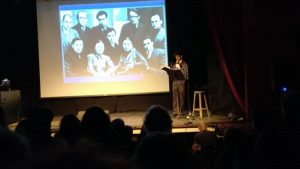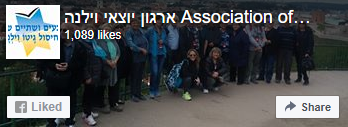Avraham Sutzkever-The Vilna Ghetto
“The Vilna Ghetto” /Avraham Sutzkever; translated from Yiddish by Vicky Shifris. Published by Am Oved
If only Israelis had the courage to remember the Holocaust in such a way / Yaad Biran, Ha'aretz, 24/06/2016
The Vilna Ghetto, Avraham Sutzkever’s book translated into Hebrew by Vicky Shifris, and Burnt Pearls, translated into Hebrew by Benny Mer, were part of the Yiddish Culture Evening of Jerusalem of Lithuania at its best, held at Beit Shalom Aleichem on June 2017, planned, and organized in collaboration with the Association of Jews from Vilna and Vicinity. Prof. Avraham Novershtern led the packed hall, on a journey of literature and poetry from old and beloved Vilna, on the eve of WWII and the Holocaust, with the participation of Dori Engel, Benny Mer, and Regina Dricker with the Nehama Lifshitz Yiddish Art Song Ensemble and Rina and Mira, daughters of Avraham - an extraordinary experiential event
In the book of testimonies of the great Yiddish poet Avraham Sutzkever, written in 1944, witness and poet struggle with each other. It is precisely in this conflict that the text best reflects the paradoxes and difficulties inherent in remembering the Holocaust. The book of testimonies begins on June 22, 1941 with the Nazi invasion of Lithuania: "I ran outside, wherever my feet carried me. I entered the house of Noach Prilutski . He was immersed in working on his essay ‘Yiddish Phonetics.’ 'With the first bomb he dropped on Russian soil, Hitler dug a grave for himself,’ said Prilutski, “but he does not know what to do about it”. He turned back to writing his essay
Prilutski, who fled Warsaw to Vilna at the outbreak of the war, was right in what he prophesied. But at that moment of the story, concrete ignorance overshadows this prophecy. Even for those who already know history, this prophecy is no consolation, since even though Hitler dug himself a grave, he managed, in the next three years, to pull in after himself many millions. Sutzkever twice repeats the name of Prilutski’s essay on ‘Yiddish Phonetics,’ as a testimony, this is an unnecessary repetition, but a significant repetition as a poem. It is a metaphor – either as a legacy of spiritual heroism or of bitter tragedy
Prilutski’s story is related to Sutzkever's role in the Paper Brigade. The Nazis, eager to document and preserve the culture of the people they sought to exterminate, selected several intellectuals from the Vilna Ghetto, Sutzkever among them, to sort the cultural treasures at the YIVO Institute (the Yiddish Scientific Institute, later called The Institute for Jewish Research) and other libraries in Vilna, and decided what to send to a museum in Germany and what to send to a paper recycling plant. These forced laborers were ordered to take part in the destruction of their culture, but violating the order, tried to save as much as they could. They hid manuscripts in various places in the YIVO building, smuggled some of them into the ghetto, burying them in hiding places. The witness’ voice tells of human heroism thanks to which important cultural assets were saved. The poet's voice rises between the cracks of this absurd, evil and metaphorical reality
In his poem "The Lead Plates of the Rom Printers,” Sutzkever elevates absurd reality into a heroic legend about partisan revolt forged by the power of cultural heritage. But even in the book of testimony, seemingly prosaic, the metaphor is present in full force. Thus, through an ostensibly random list of texts smuggled into the ghetto under the pretext of waste paper for heating purposes: "Tolstoy's letters (...), Shalom Aleichem’s manuscripts, Gorky’s, Bialik’s, and Roman Roland’s letters, rare books from the 15th and 16th centuries, a painting by Rafin, the diary of Dr. Herzl, the manuscript of the Vilna Gaon and drawings by Marc Chagall"
He goes into more detail, as the manuscripts in the right hands arouse the fighting spirit: "I found a document signed by the Polish-Lithuanian freedom fighter, Tadeusz Kościuszko. (who took part in the American Revolutionary War). I handed the document to a Polish woman (...) .The next day she came to my workplace and told me that when she showed Kościuszko’s signature to members of the underground organization to which she belongs, it affected them like a spark in burning dust." This was a far-reaching metaphor at the heart of the testimony: The Jewish intellectual forced by the Nazis to destroy his culture, smuggles a document that has the symbolic power to ignite the spirit of Polish uprising, to connect Jews and Poles and help bring about the end of the rule of evil
The power of Sutzkever's testimony lies in his refusal to make a simplistic narrative of redemption. The last pages of the book describe his return to Vilna after its liberation, and the discovery of some of the manuscripts that had been hidden. Here, too, he lists the names of the authors, as if he seeks to redeem from its hiding place the entire glorious Jewish culture. But he also writes: "In the corner on the left, we dug and extracted the sculptures, most of which were taken from the An-ski Museum. When rescuing Antokolski's statue of 'David', this happened: while turning the soil over, a hand appeared. I grabbed it and a shiver went through my body, it was not made of plaster. It turned out that Jews were hiding in this melina after the liquidation of the ghetto. One of them died, and was buried next to Antokolski's statue
The heroic act of saving cultural treasures lies in metonymic proximity to the deaths of millions, and the redeeming power of the metaphor shrinks again in the face of horror
The need to look at the horrible reality symbolically seems to be essential to human life. But in his book of testimony, unlike in his poems, Sutzkever's poetic power is expressed in his restraint, in his refusal to let the metaphor take over the narrative and create a false semblance of redemption. Sutzkever thwarts his metaphors, and instead of rising to catharsis, they fall back to the floor of the blood-stained abattoir. The search for meaning collides against the meaninglessness and arbitrariness of evil. This movement is the essence of Holocaust remembrance in Sutzkever's testimony
It testifies to the underground heroism of the Vilna ghetto and the partisans, but does not create a narrative that simply leads from the Holocaust to heroism, and does not differentiate between those who went "like sheep to the slaughter" and those who rebelled. Evidence from the valley of killing in Ponar is presented in the book precisely after the chapter describing the activities of the underground. Sutzkever also tells the wonderful story of the Vilna Ghetto culture - schools, cultural events, and the theater - these appear a few pages after the testimony of a Ponar survivor, Tama Katz, who makes it clear to ghetto residents that liquidation is a systematic and final process
Is this the victory of the spirit over the physical or the madness of those who perform plays in a cemetery? The way Sutzkever places facts side by side suggests that both answers are correct. Holocaust and heroism, oppression and struggle are mixed together. Schools were set up in the Ghetto, and Vilna's dedicated educators gave their lives to teach children in an impossible reality. However, in the last part of the book, Sutzkever also tells of the presentation of school graduation certificates in the Ghetto found in the Ponar death pit, upon which is written: "Vilna Ghetto. Department of Culture, Assistance to Children. Number 9. We hereby confirm that Rudnitsky Laser graduated from the Ghetto Elementary School
Sutzkever does not liberate his metaphors. If writing poetry after Auschwitz is a barbaric act, as the German philosopher Theodor W. Adorno says, the silence of poetry after Auschwitz is also a barbaric act. The attempt to describe history "as is," unfiltered, has often become a pornography of death; and one must wonder of its effect on generations who grew up on the description of atrocities that the psyche has no power to contain. Conversely, the attempt to extract meaning from horrible reality has often failed to turn the Holocaust into a metaphor that is primarily intended to facilitate the continuation of bourgeois life
Anne Frank's diary has become an international bestseller, in part because the story of a good-natured, talented and life-loving girl, whose family has been forced by Nazi law arbitrariness to hide in an attic, befits the Western bourgeois consciousness. What is more, there is no need to exaggerate the relief offered by most Israeli Holocaust stories emphasizing Holocaust survivor rehabilitation in the Jewish state. Sutzkever's testimony is more complex, multifaceted, and therefore even more difficult to digest
Sutzkever also praises the heroism of his Lithuanian savior Yanova Bertushevitz, and retreats from a simplistic division between good Jews and bad Gentiles. However, the act of rescue, a masterpiece of humanity in the heart of hell, inserted between two arbitrary coincidences, prevents its being transformed into a simplistic narrative of redemption. When Sutzkever first fled the Ghetto, he did not know where to go. "I went where my feet led me. Since I do not know anyone here, I built a system: I would enter the third alley, knock on the seventh door, and there, I hope, would find shelter and rescue." Then, when he wanted to return to the Ghetto because he worried about the family he had left behind, his savior tried to help: " 'Stay here,' she spoke to my heart," 'I will bring your mother here "
Sutzkever also observes killers, and is not satisfied with talking about another planet or human beasts. ¨Kittel is an actor, a singer, a graduate of the Berlin School of Acting and the Frankfurt School of Murder. The knowledge he studied in each of the schools he bound into a 'harmonious' unity.” He used to play his silver saxophone and joined in the singing. (...) At first glance, it is difficult to describe Kittel for what he really is. He is constantly smiling. His teeth gleam from a distance. He always prefers the smell of perfume; he is elegant and polite, fashionable and well-educated. When he travels to the province, to carry out some massacre, he takes the saxophone with him.” These sentences have no historical explanatory power, and do not trace the roots of Nazism, but do have poetic power. It is a subdued poem, created by the disturbing proximity of what is perceived as an internal contradiction; a poem that evokes unease and cries out in the face of a reality of meaningless evil
The introduction to the book by Avraham Noverstern and Justin Cami makes it easier to place the text in its biographical, historical and political context, and allows for a clear understanding. The appendices at the end of the book, detailing information about people and places in Jewish Vilna, and the clear timetable of the Vilna Holocaust, also help to make the text a valuable study tool
I wish Israelis had the courage to remember the Holocaust this way, in the wise and complex voice of an intellectual who physically experienced its horrors, and gives his testimony so close to its occurrence, and whose every fiber is connected to the culture of its victims




